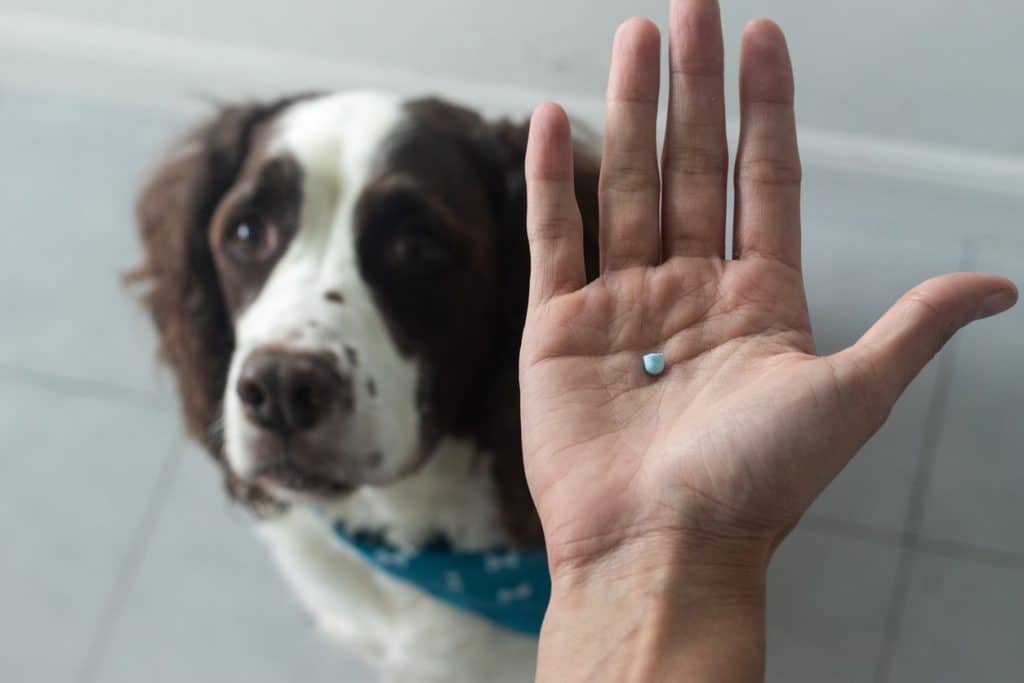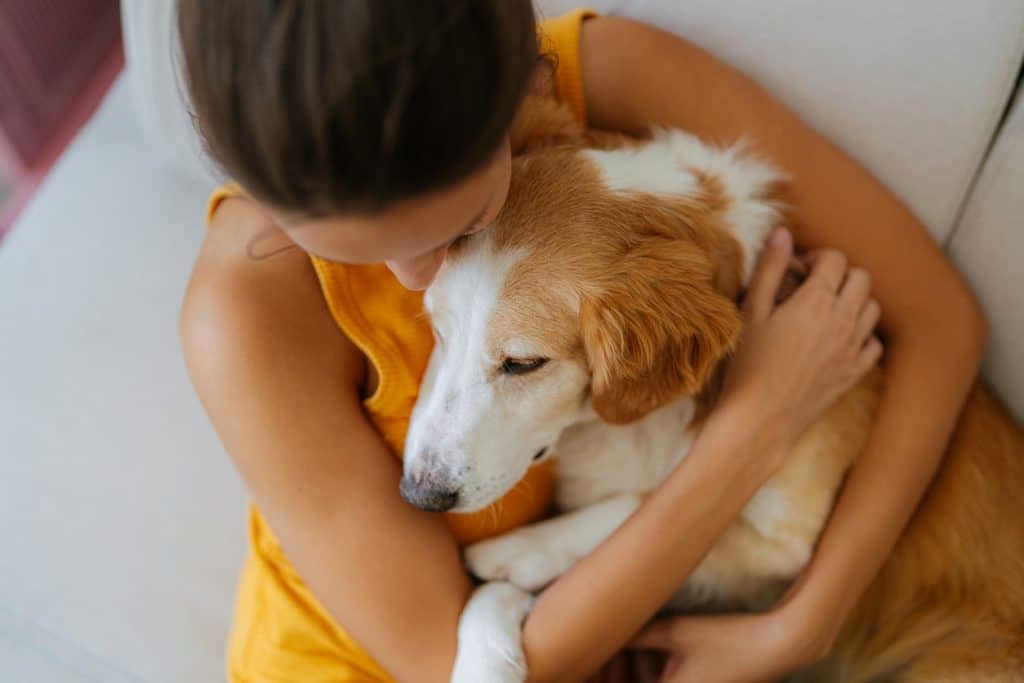Dog storm anxiety, or thunderstorm phobia, can cause dogs to experience stress and show unusual behaviors.
“A dog may become anxious when there are signs of an approaching storm and fearful when lightning actually strikes,” says
Dr. Denise Johnson, DVM, CCBC. Rest assured, storm anxiety is common in dogs, and many treatments for it exist. Dog thunderstorm anxiety treatments include supplements, anxiety medication, behavioral modifications, and professional assistance.
Below, we’ll discuss what causes storm anxiety, how to treat it, and tips for staying calm when
your dog is experiencing stress.
[toc]
Why Are Dogs Scared of Thunder & Storms?
Storm conditions, including thunder, lightning, and rain, can trigger a dog’s anxiety. According to Dr. Brad Hinsperger, B.Sc, DVM, common reasons for dog storm anxiety include the following:
- Loud noises, due to a dogs’ sensitive hearing
- Uncomfortable tingling, due to static electricity in dogs’ fur
- Air pressure changes that happen before a storm
- Negative memories and trauma due to past storm experiences
If you're ever unsure about what's causing your dog's storm anxiety, see a vet or dog behaviorist.
Signs Your Dog Is Afraid of Storms
Pet parents worried about their pups during a storm might not know what to look for. Luckily, storm anxiety symptoms are similar to typical
dog anxiety, which includes the following:
While these are common signs of thunderstorm phobia or anxiety in dogs, be mindful of any unusual behavior.
[caption id="attachment_267078" align="alignnone" width="1024"]

iStock/smrm1977[/caption]
How to Treat Storm Anxiety
While storm anxiety can be scary for you and your dog, treatment is highly accessible. It’s best to start with one or two treatments, then add others and make changes as needed until you find what works best for your dog.
Dr. Jennifer E. Feeney, DVM, UW-AAB, with
Better Bond Behavior, and Dr. Johnson suggest the following treatments for storm anxiety, ranging from simple supplements to more professional intervention.
1. Supplements
Over-the-counter, food-grade
supplements can relieve dog storm anxiety. Dr. Feeney says these supplements usually include Solliquin, Zylkene, and Composure. "[They're in the] form of a yummy daily treat and contain ingredients like green tea extract and colostrum," she adds.
Additionally, she explains that many pet parents prefer supplements because they're considered natural. However, unlike pharmaceuticals, they’re mostly unregulated, so choose supplements with care and consult your vet with any questions.
2. Anxiety jackets or wraps
An anxiety jacket is a coat that provides constant, mild pressure to help soothe your dog. Dr. Johnson says Thundershirts and other anxiety wraps work best for dogs who seek out contact when stressed.
Research shows that
the pressure from anxiety wraps is therapeutic and reduces the severity of clinical anxiety symptoms by almost 50%. No adverse effects were reported when using an anxiety wrap.
You can use an anxiety jacket or a
ThunderShirt for your dog when you know a storm's coming. However, it's important to acclimate your dog to wearing a dog jacket, shirt, or vest to ensure they're comfortable. Have them wear the jacket or wrap for a few minutes every day, whether there's a storm or not. Then, praise them with
delicious treats and positive words.
3. Calming pheromones
Dog-calming pheromones are species-specific chemical signals that send comforting messages and support calmness."There are several brands of pheromones to help dogs feel calm," says Dr. Feeney. For example,
ThunderEase makes a calming spray,
collar, and
diffuser kit that can help treat dog storm anxiety.
Dr. Johnson also recommends Adaptil or Zenodog. These products provide ongoing support for dogs facing unpredictable storms or those who have other sources of stress, like
separation anxiety.
4. A safe space in your home
Dogs with thunderstorm phobia or storm anxiety can benefit from having a safe space. Ideally, this will be in the middle of your home and far from windows or doors, so storm conditions aren’t easily heard or seen.
Dr. Feeney and Dr. Johnson suggest having the following items in your dog’s safe space:
[caption id="attachment_267079" align="alignnone" width="1024"]

iStock/Hugo Alejandro Salazar S[/caption]
5. Medications
While pet parents might feel uncomfortable giving their dogs medications, Dr. Feenery says that "in reality, it's more compassionate to support your dog's mental health with medication if it can help them feel more relaxed."
Luckily, there are several dog-safe
anti-anxiety medications, like
Xanax and
Tazadone. You can
give your dog prescription medication 60 to 90 minutes before a storm to decrease the physiologic response to their fear. For example, it can help them avoid feeling a pounding heart or other fight or flight stressors that signs of a storm can cause.
6. Behavioral modifications
If you're looking for a more hands-on approach to treating your dog's storm anxiety, Dr. Johnson says there are ways to modify these behaviors.
- Sound desensitization: When the stimulus (a storm) isn’t present, desensitize your dog to storm sounds using a storm playlist on YouTube. Start at a low volume and gradually increase it as your dog gets used to it. Follow this activity with a treat.
- Foundation training: Train your dog to practice settling activities like sitting and lying down to establish a relaxation routine. Introduce and practice this outside of when a storm is happening, making it easier when it's needed.
- Positive reinforcement: When you’re practicing sound desensitization and foundation training, and when your dog responds well during storms, offer treats and praises for positive reinforcement.
Dr. Feeney adds that with "proper behavior modification that desensitizes your dog to storms and counter conditions their fear into something more positive, your dog can become fear-free during storms.”
7. Professional assistance
If you're struggling to treat your dog's storm anxiety at home, Dr. Feeney says a pet behaviorist or credentialed trainer can help.
There isn't a
nationwide set of credential standards to help you find professional assistance, but
choosing a certified behavior or training professional who uses positive reinforcement training and behavior modification is best.
How to Stay Calm During Storms
Dogs can
pick up on your emotions, so staying calm is key to helping your dog feel comfortable. Your plan can include:
- Finding a few thunderstorm anxiety treatments your dog is comfortable with before a storm happens
- Offering training treats for positive reinforcement
- Using a calm and quiet voice to reassure your dog that everything is okay
- Getting close to them when speaking to and comforting them, as opposed to towering over them
[caption id="attachment_267080" align="alignnone" width="1024"]

iStock/AleksandarNakic[/caption]
Takeaway
Although storm anxiety isn't always easy to cure altogether, understanding how to treat it can help you and your dog. Try different treatments to find what works best to help your dog feel comfortable during storms and improve their well-being long-term.
 iStock/smrm1977[/caption]
iStock/smrm1977[/caption]
 iStock/Hugo Alejandro Salazar S[/caption]
iStock/Hugo Alejandro Salazar S[/caption]
 iStock/AleksandarNakic[/caption]
iStock/AleksandarNakic[/caption]